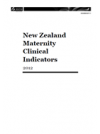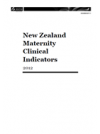The New Zealand Maternity Clinical Indicators are the result of collaboration between the Ministry of Health and maternity stakeholders representing consumer, midwifery, obstetric, general practice, paediatric, and anaesthetic perspectives. In 2011 an expert working group established a set of 12 maternity clinical indicators that could be measured using the available data collections at that time.
In 2013 the National Maternity Monitoring Group reviewed the original indicator set and recommended a range of changes to improve the quality, completeness and scope of the New Zealand Maternity Clinical Indicators. These proposed changes were further reviewed and developed by the original expert working group to ensure the objectives of the New Zealand Maternity Clinical Indicators were retained; that being a tool for assessing the quality and national consistency in the delivery of maternity services in New Zealand.
This report presents the first year of these revised indicators. In addition to improved quality and completeness of the existing 12 indicators, three new indicators have been added that reflect care during pregnancy and the postnatal period and severe maternal morbidity.
For this report, as with previous reports in this series, the ‘standard primipara’ definition is used to identify a group of women for whom interventions and outcomes should be similar. Of the 15 indicators covered in this report, eight apply to standard primiparae, four apply to all women giving birth, two apply to women who registered with a Lead Maternity Carer and one applies to all babies born.
Since 2012, district health boards (DHBs) and maternity stakeholders have used the indicators in their local maternity quality and safety programmes to identify areas warranting further investigation at a local level. Using the data in this report DHBs and local maternity stakeholders can expand the scope of their investigations and view trends over a four year period.
As the three previous reports demonstrated, maternity service delivery and outcomes vary between DHBs and between individual secondary and tertiary facilities. These findings merit further investigation of data quality and integrity as well as the local clinical practice management reasons for these variations.
Purpose
The purpose of the New Zealand Maternity Clinical Indicators is to:
- highlight areas where quality can be improved at a national level
- support local quality improvement by helping DHBs to identify focus areas for local clinical review of maternity services
- provide a broader picture of maternity outcomes in New Zealand than that obtainable from maternal and perinatal mortality data alone
- provide standardised (benchmarked) data allowing DHBs to evaluate their maternity services over time and against the national average
- improve national consistency and quality in maternity data reporting.
The New Zealand Maternity Clinical Indicators are evidence-based and cover a range of procedures and outcomes for mothers and their babies. Where possible the New Zealand Maternity Clinical Indicators are aligned with international maternity indicators to enable international comparison.
Key Results
Summary of changes
Three changes, enabled by improvements in nationally collected data, have been made to this current report compared to the previous reports. They are:
- improving the accuracy of the standard primipara calculation
- expanding the population covered by the indicators to include births occurring outside maternity facilities, and
- introducing three new indicators.
Standard primipara
The standard primipara represents a woman expected to have an uncomplicated pregnancy; intervention and complication rates for such women should be low and consistent across hospitals. Compiling data from only standard primiparae (rather than all women giving birth) controls for differences in case mix and increases the validity of inter-hospital comparisons of maternity care (adapted from Australian Council on Healthcare Standards 2008, p 29).
For this report, a ‘standard primipara’ is defined as a woman aged between 20 and 34 years at the time of birth, having her first baby (parity = 0)1 at term (37 to 41 weeks gestation) where the outcome of the birth is a singleton baby, the presentation is cephalic and there have been no recorded obstetric complications that are indications for specific obstetric intervention. Standard primiparae account for approximately 14% of all births nationally; this proportion varies across DHBs.2 See ‘Appendix 1: Technical notes’ for more information on definitions.
Changes to data sources for the 2012 report have improved the accuracy of the standard primipara calculation but do not change the definition of a standard primipara.
Population
The population from which the indicators are derived has changed. Due to system limitations, previous reports focused on women giving birth and babies born in maternity facilities only. For 2012 onwards, where possible the scope of the indicators is expanded to all births known to the Ministry of Health, including births not occurring at a maternity facility – that is, home births and births where the location was unknown. Indicators 1 and 14 cover all women registered with a Lead Maternity Carer, indicators 10 to 13 cover all women giving birth (regardless of birth location) and indicator 15 covers all babies born (regardless of birth location).
For 2012, indicators 2 to 9 (standard primiparae) are limited to women giving birth at a maternity facility. Alternative methodologies to expand the definition of standard primipara to accurately include births not at a maternity facility are being developed and tested, and are expected to apply from the 2013 report onwards.
New and modified indicators
The existing preterm birth indicator (indicator 15) has been modified in this report to include all babies born under 37 weeks gestation (that is, all live births between 20 weeks 0 days and 36 weeks and 6 days). A breakdown of babies born under 32 weeks and 32 to 36 weeks gestation for 2012 is provided in this report.
Three new indicators have also been added. These additions reflect government policies such as the Health Target ‘better help for smokers to quit’, the recommendations of the National Maternity Monitoring Group regarding timely access to a Lead Maternity Carer, and an increased focus on severe morbidity by the Perinatal and Maternal Mortality Review Committee.
Further indicators of severe maternal morbidity and infant outcomes will be considered for future reports.
Table 1 lists numerators and denominators for the 15 Clinical Indicators presented in this publication. Previous years’ data (2009 to 2011) has been reproduced using the new definitions to enable a comparison over time.


